Tropicalesque Tanglewild, where bananas and palms grow big and bold
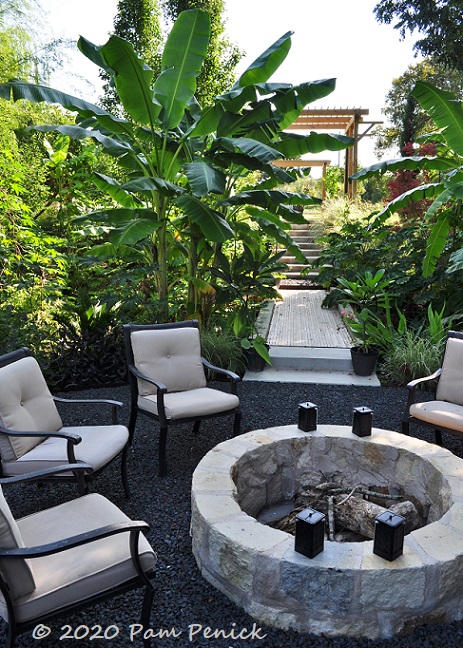
With the arrival of cooler weather it’s garden visiting season, and I’ve started calling on gardening friends who are willing to have me over for a socially distanced, masked, outdoor visit. How I love touring gardens! This week’s tour is at Tanglewild Gardens, a 1.7-acre garden in north Austin’s Wells Branch neighborhood, the creation of Skottie O’Mahony and Jeff Breitenstein.
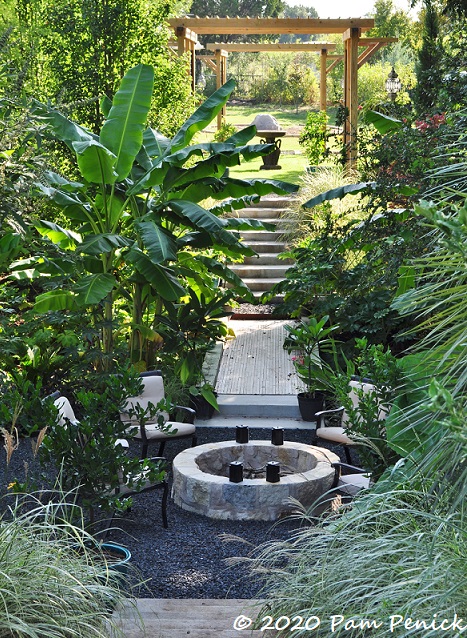
It’s been two years since I saw Tanglewild on the Garden Bloggers Fling tour, and wow, what a lot has changed since then. In the spring of 2018, the lower part of the garden by the creek was just starting to be planted, and pathways in that area were simple mown-lawn or mulch. Today a limestone fire pit encircled by banana trees and other tropical-looking plants beckons you down a flight of stairs to a gravel patio.
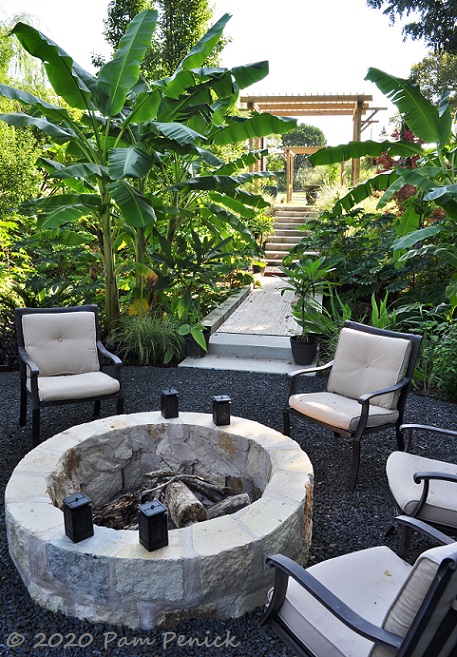
Cushy chairs invite you to sit a while, and a low-profile, wood-plank bridge leads on across the creek to another flight of stairs and a tall arbor doorway.
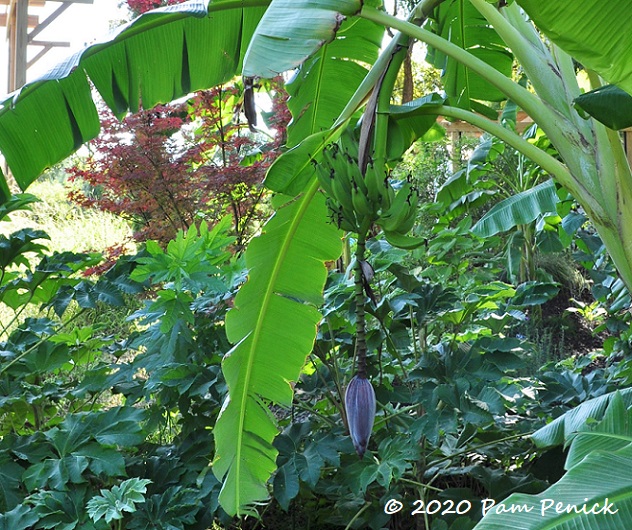
Skottie pointed out that their bananas are producing! See the cluster of upside-down, green bananas at the top of the spent flower stem? I didn’t know bananas would produce fruit in our 8b hardiness zone, but obviously certain ones will. When I asked about taste, though, Jeff made a face.
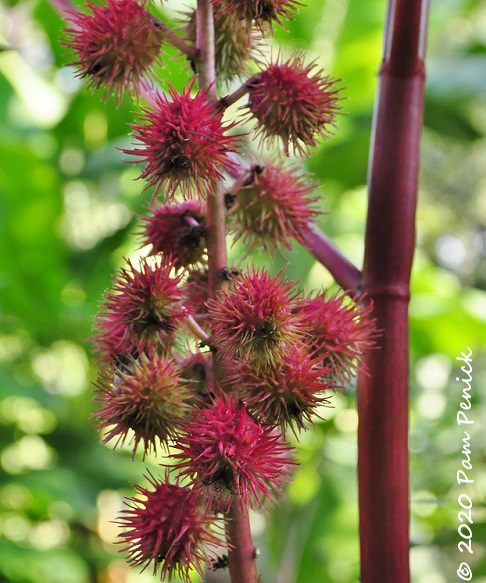
Castor bean seedpods
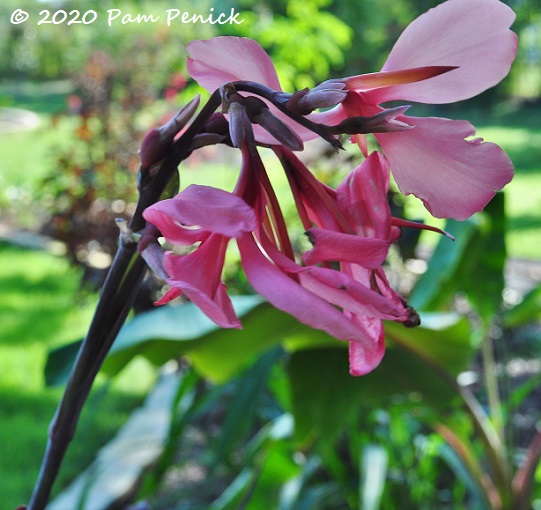
Canna flower
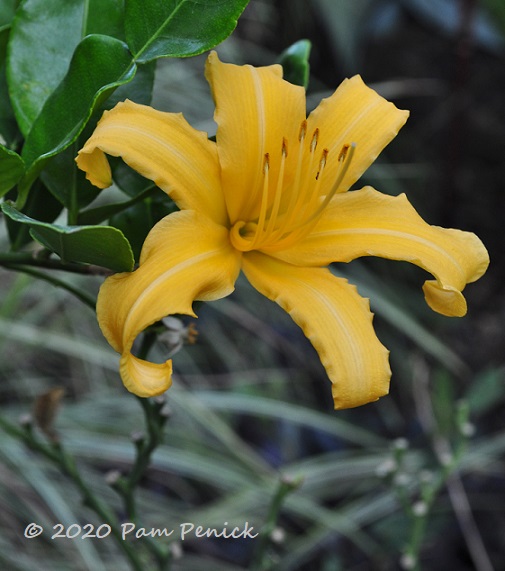
Jeff and Skottie are into daylilies and are hybridizing them to find the hardiest ones for Austin’s hot, drought-prone climate. They have 800 different daylily varieties, or maybe more by now. On the mid-September day I visited, this was the last one in bloom for the season.
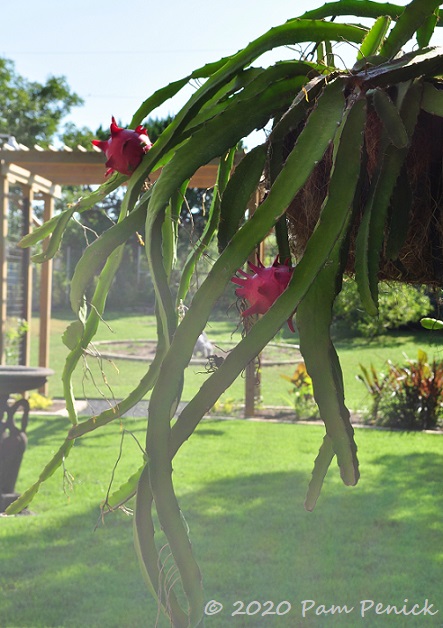
A hanging dragon fruit cactus caught my eye at the top of the stairs.
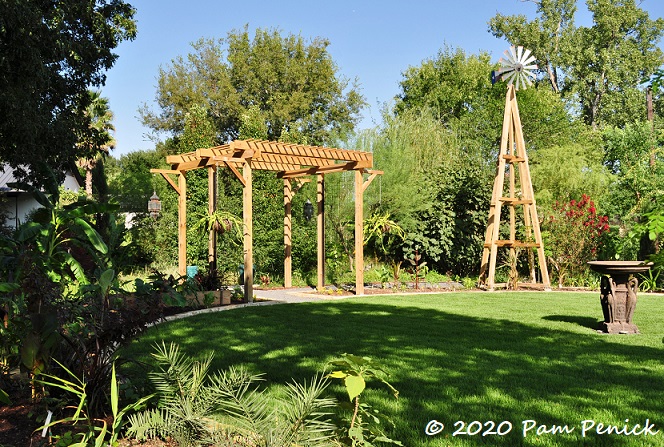
A circular lawn framed by arbors, a windmill, and beds of tropicalesque plants is Jeff and Skottie’s latest project. They intend to create a wedding venue and event space in this part of their garden.
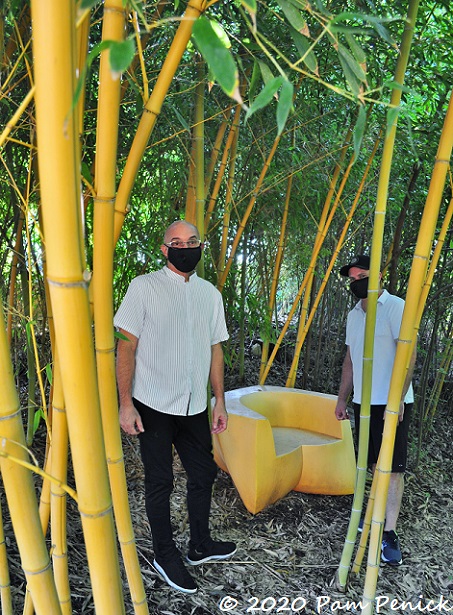
Hidden in a stand of yellow bamboo overlooking the creek is Jeff’s man cave, complete with banana-yellow lounge chair. Skottie (left) and Jeff provide a sense of scale — it’s almost a bamboo forest!
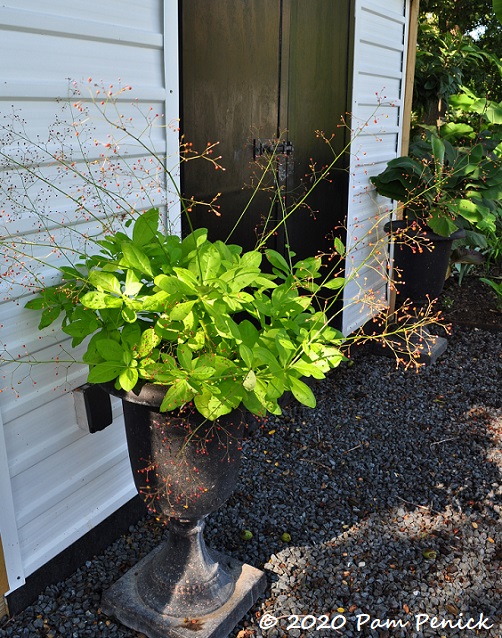
Jewels of Opar (Talinum paniculatum) offers up sparkling sprays of seedpods atop chartreuse leaves — such a pretty plant, but also an aggressive self-seeder. I may have to try it next year. Anyone want to talk me out of it?
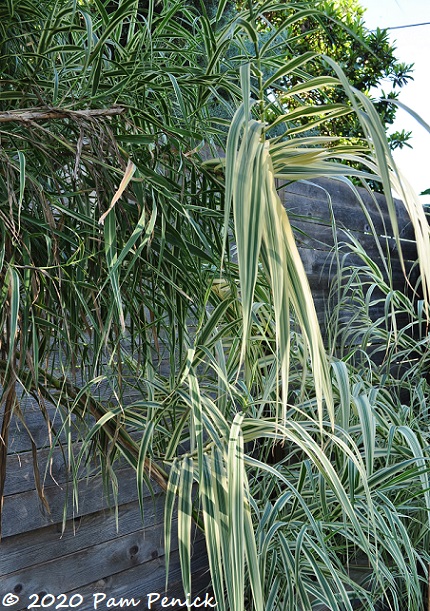
Variegated giant reed grass
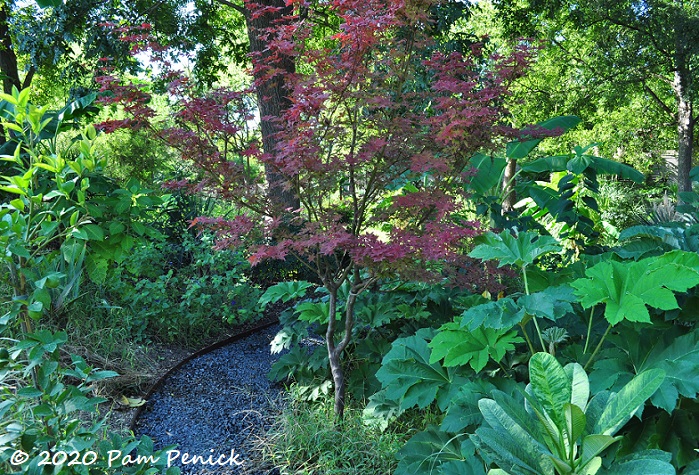
Back at the fire pit circle, we took a new path (new since May 2018) curving past a red Japanese maple.
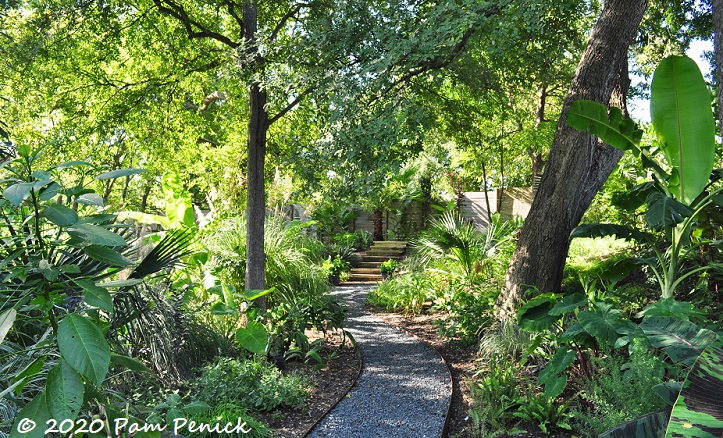
This area is shaded by tall trees, including the sword tree with Texcalibur (see my previous post about Tanglewild). The black gravel path winds past bananas, palmettos, and other bold-leaf subtropical plants.
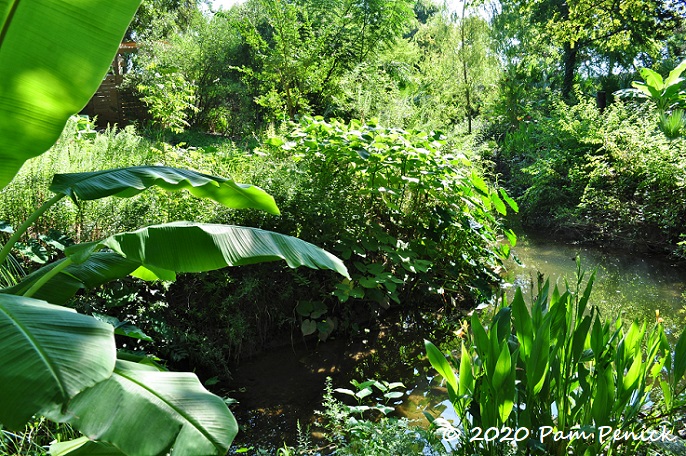
Tar Branch Creek curves placidly through the lower garden, home to several snapping turtles and at least one big water moccasin (they showed me a photo!). The water sometimes climbs its steep banks and overflows across the fire pit patio and bridge when Austin gets one of its epic rainstorms.
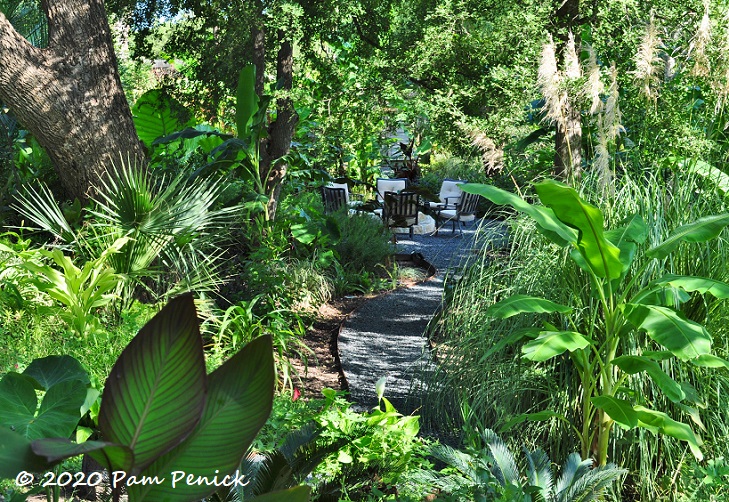
Looking back along the path, the fire pit patio draws your eye through the jungly understory.
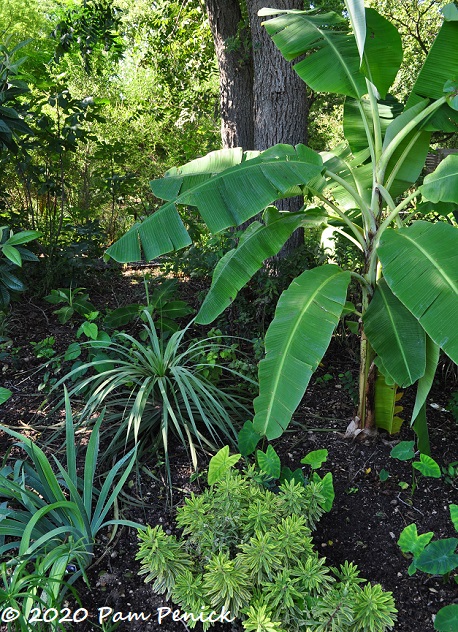
Skottie and Jeff grow many kinds of plants I’ve never attempted, or have attempted and failed at, including ‘Ascot Rainbow’ euphorbia (the yellow-green plant at bottom. I’ve killed 3; Skottie confessed to killing more to end up with a handful of survivors), bananas, tropical annuals, and all kinds of broad-leaf plants. As such, they have an exotic (to my eyes) plant palette. It feels like entering another part of the world when exploring their garden.
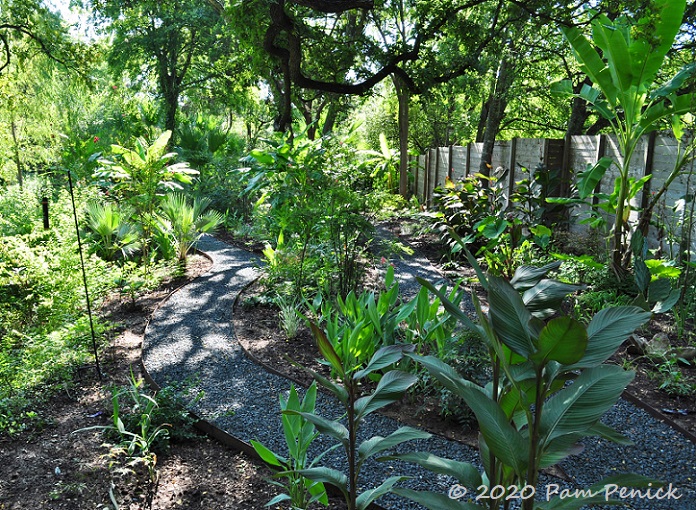
The path divides down this long stretch that runs along the creek, allowing you to explore one side and then the other as you return, immersing you in foliage.
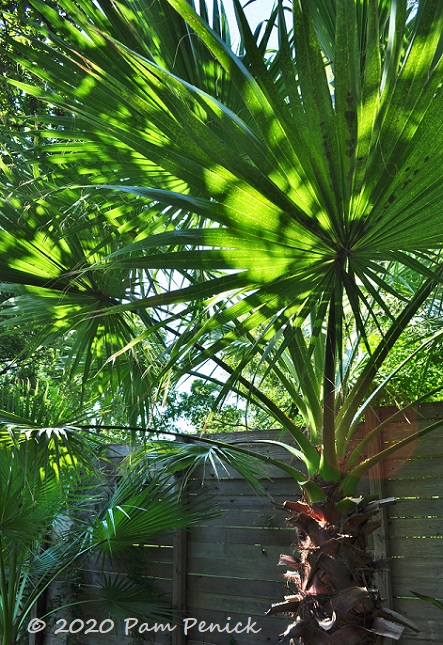
Palms and palmettos grow abundantly throughout the garden, adding to the tropical vibe even though they are perfectly hardy here.
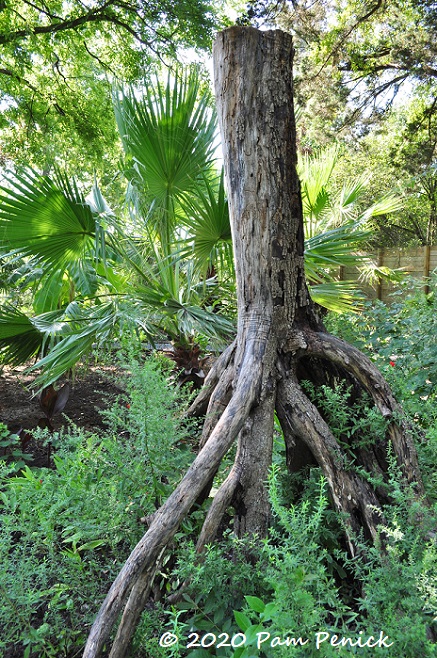
This upside-down tree trunk makes a natural sculpture and focal point.
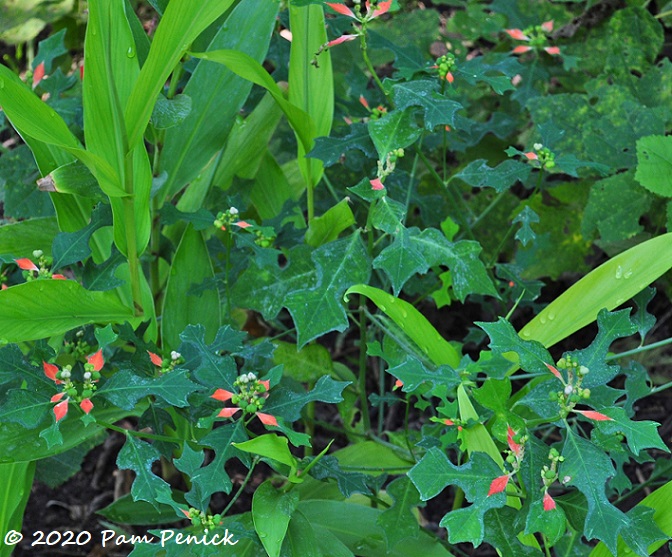
Texas’s native poinsettia (Euphorbia cyathophora)
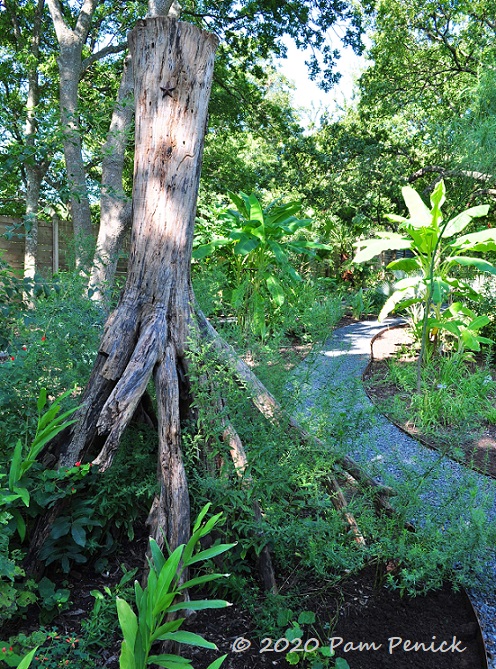
Coming back up the trail
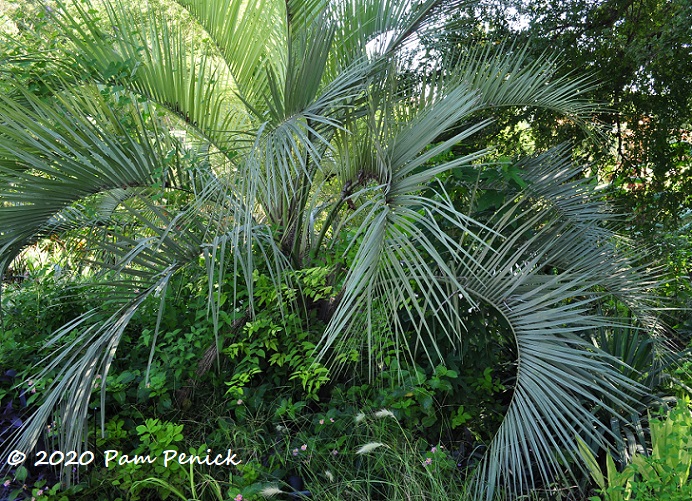
I kept asking Skottie about the palms, which add so much texture and drama to their garden. I think this is a pindo palm. (Should have taken notes!)
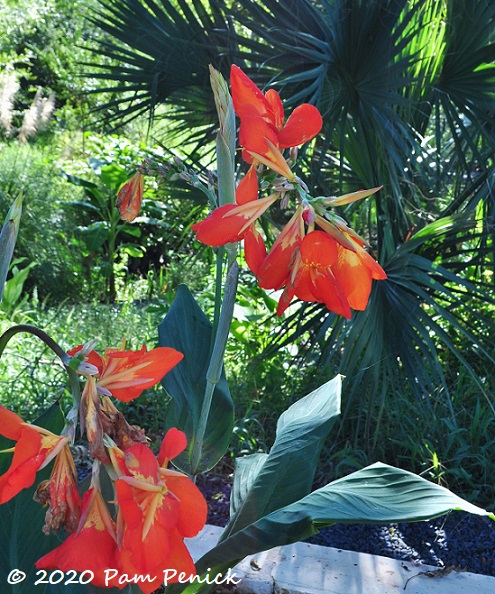
A stunning orange canna
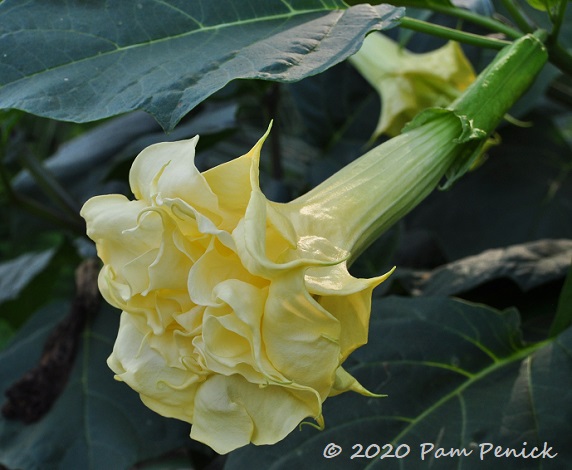
And check out this gorgeous double yellow datura! I’d love to try this one.
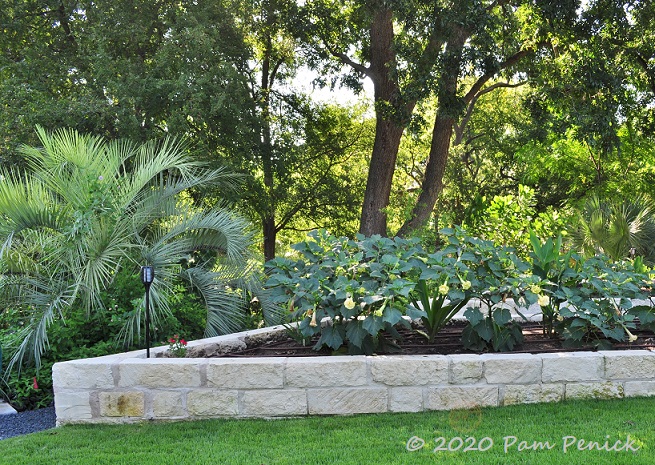
Raised beds of limestone hold a long swath of the yellow datura and orange canna.
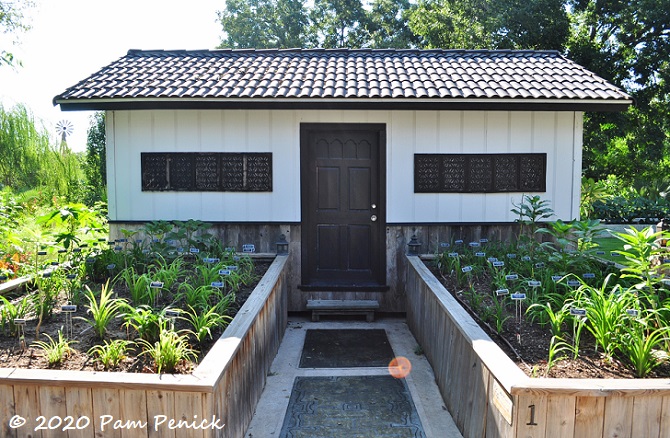
Daylily trial beds and an outbuilding with Southeast Asia style
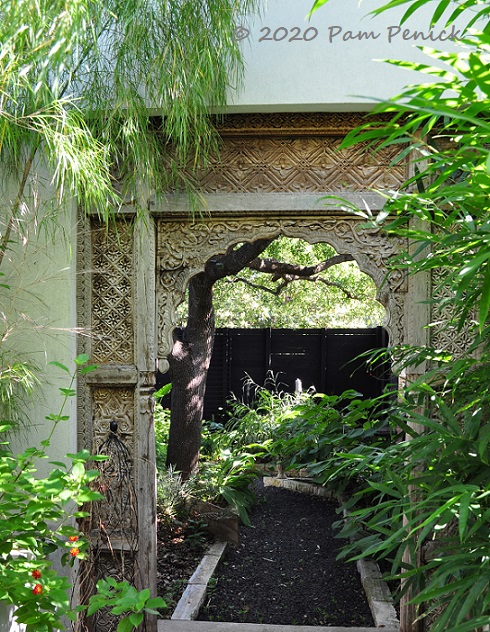
An antique teak doorway frames a view of the Moon Garden, where flowers and foliage glow white or pale yellow.
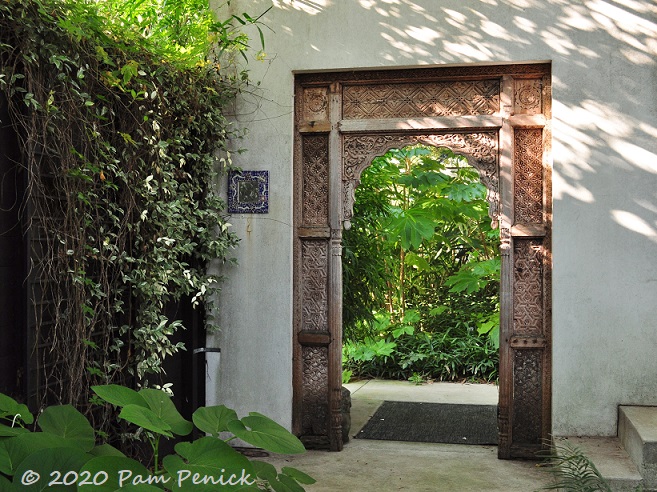
Skottie and Jeff built the white stucco wall to enclose their swimming pool patio and garden, on the opposite side.
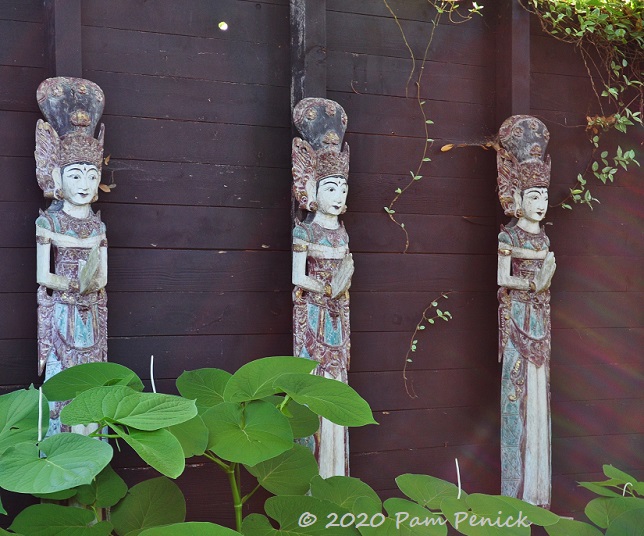
Thai rice goddess carvings hang on the dark-stained fence.
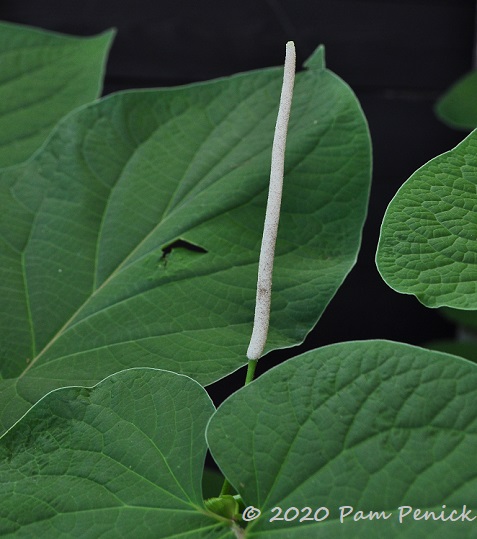
Root beer plant — named for the fragrance of its leaves — aka hoja santa (Piper auritum), is popular among Austin gardeners. Native to Central America, it’s hardy here but pouts if it doesn’t get regular water, and it returns from the roots each spring. Its leaves can be used to wrap fish and other meats for flavor when cooking. Upright, pencil-thin, white flowers add interest among the large leaves.
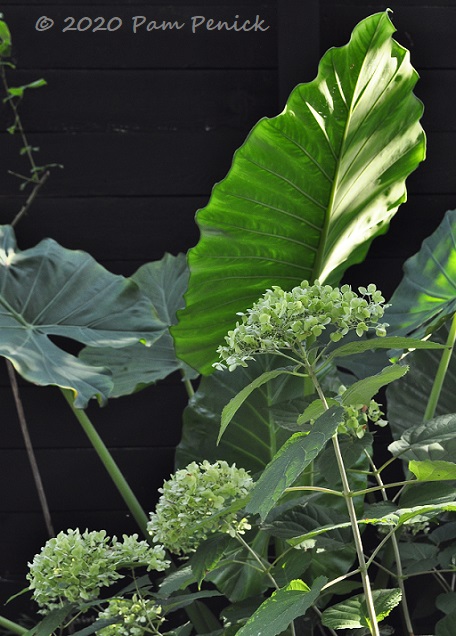
Pale-green hydrangea
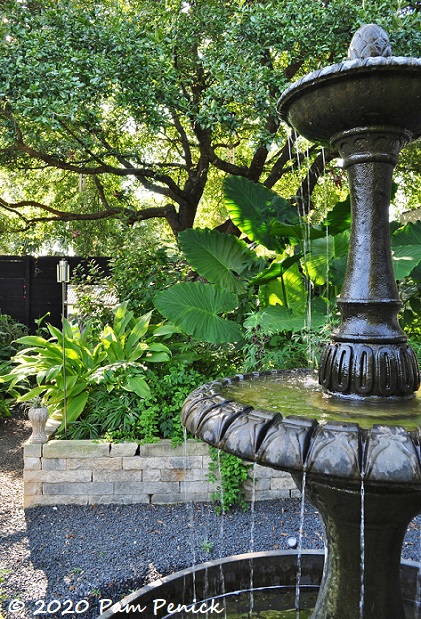
A tiered fountain in the center of the Moon Garden evokes New Orleans for me.
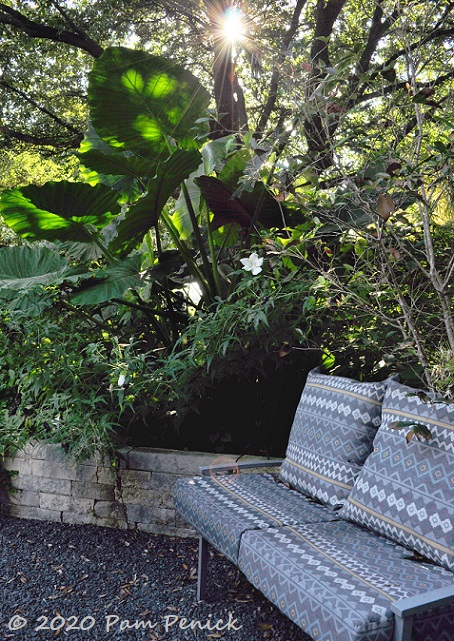
Secluded benches invite you to sit and enjoy the spilling water.
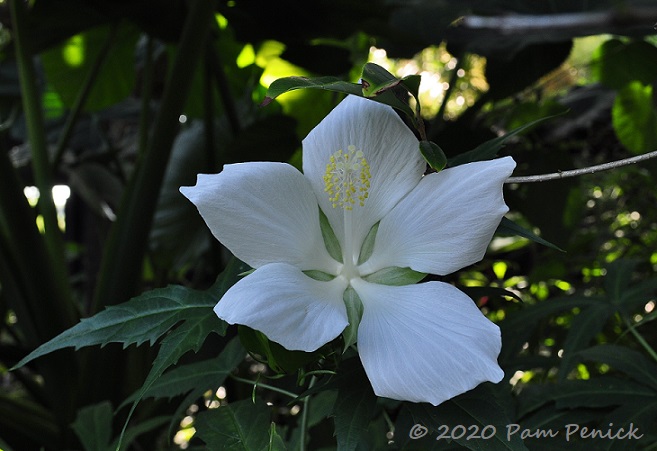
White ‘Texas Star’ hibiscus (Hibiscus coccineus ‘Alba’)
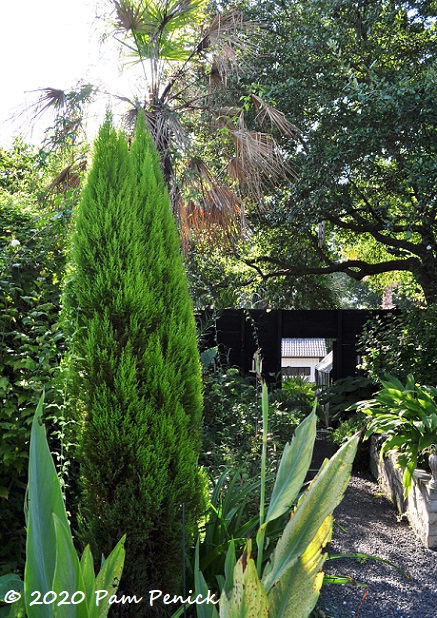
The plants, and especially the pale flowers when in bloom, are set off by tall, black fencing that surrounds this garden.
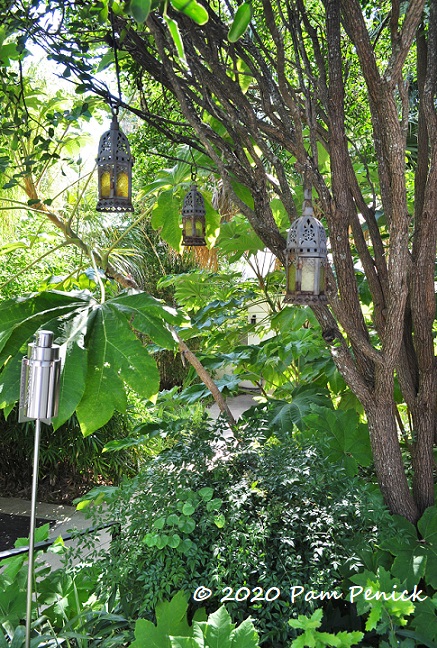
Hanging lanterns for nighttime ambience near the swimming pool
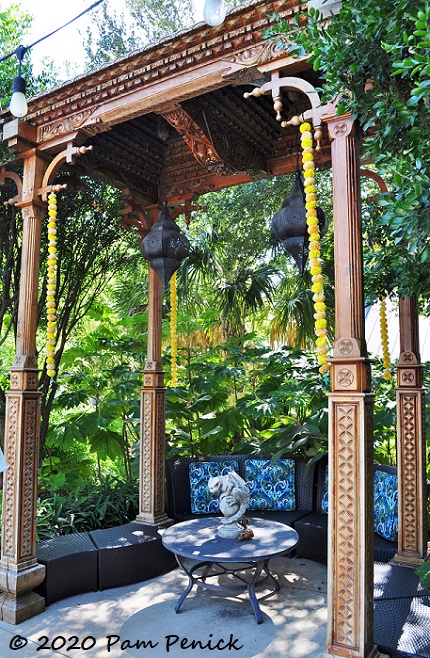
A tall carved Thai or Bali-style arbor shelters a poolside sofa.
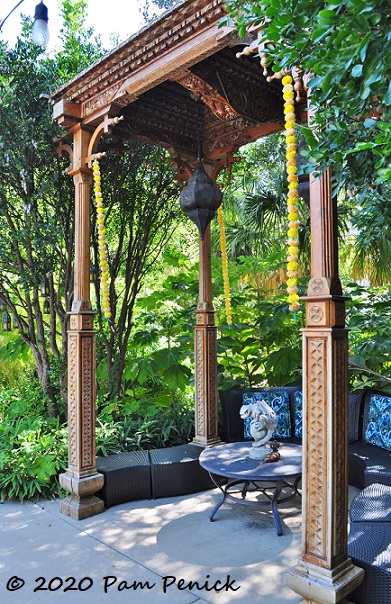
It also makes a terrific focal point from the back porch.
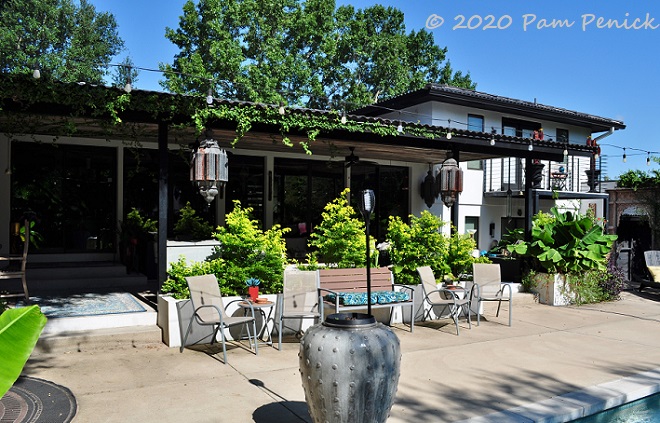
Jeff and Skottie have many inviting seating areas throughout their garden, perfect for guests to spread out at parties in pre- (and post-) Covid times.
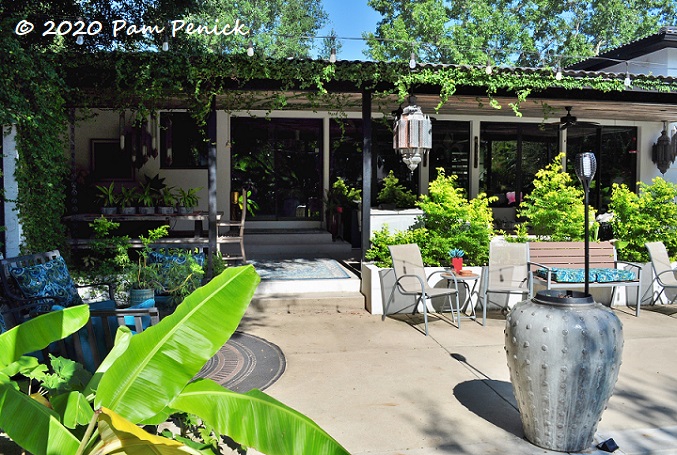
Their deep back porch offers shelter from the Texas sun.
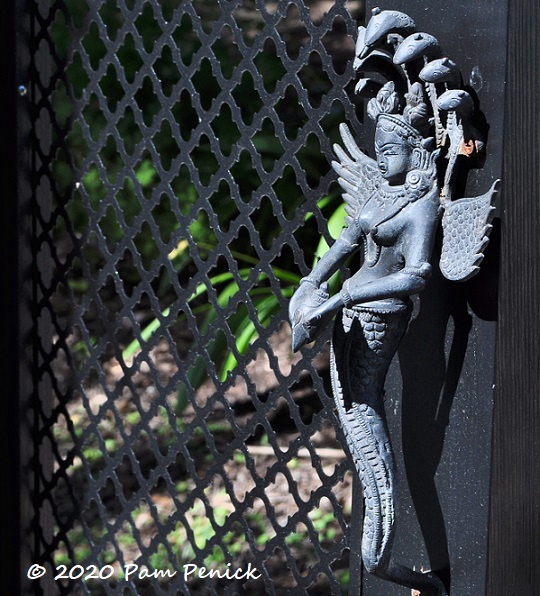
A goddess gate handle
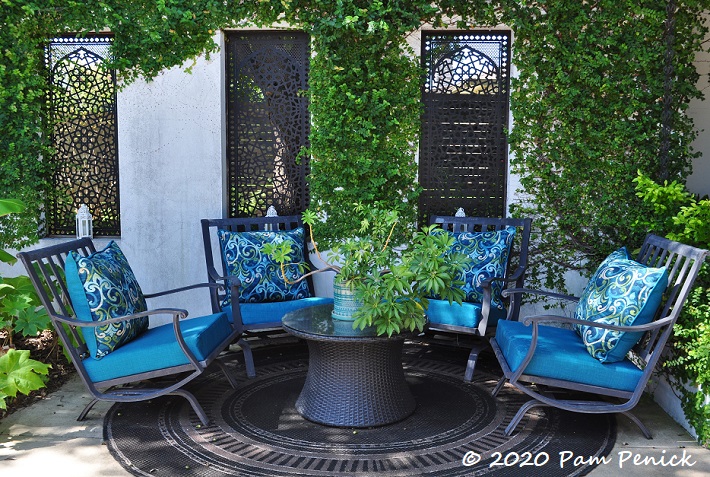
Laser-cut Moroccan-style screens allow views, light, and breezes to come through the stucco privacy walls around the pool.
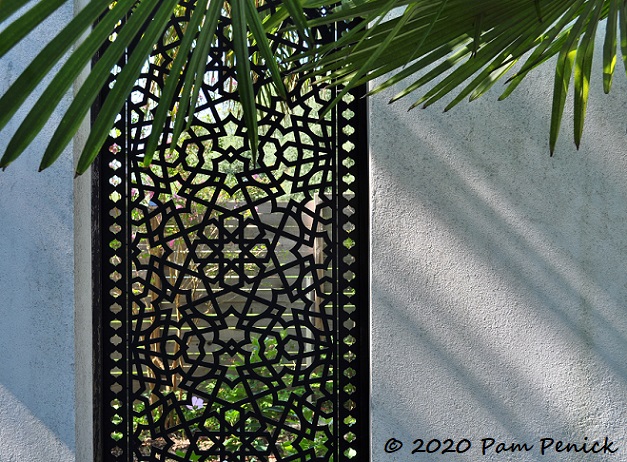
They’re part of the exotic magic of Tanglewild Gardens. My thanks to Skottie and Jeff for sharing their beautiful garden with me again!
To see pics from my visit to Tanglewild in May 2017, click here.
__________________________
Digging Deeper
Come learn about gardening and design at Garden Spark! I organize in-person talks by inspiring designers, landscape architects, authors, and gardeners a few times a year in Austin. These are limited-attendance events that sell out quickly, so join the Garden Spark email list to be notified in advance; simply click this link and ask to be added. Season 8 kicks off in fall 2024. Stay tuned for more info!
All material © 2025 by Pam Penick for Digging. Unauthorized reproduction prohibited.


Wow…lots has changed since my/our 2018 visit. I remember that upside down tree as being in a very open area, and look at it now! Thanks for the wealth of photos.
Yes, that’s how I remember that area too. The first plants had just been planted then. And now that area is not only getting quite lush but there are three other garden spaces that are already looking established. I don’t know where they find the energy and time for it all, as they both work full time and don’t employ garden helpers!
Ia there dragon fruits too? I think that it is tropical plant
Yes, I think so.
Thanks for the tour of this lovely tropicalesque garden! So nice to see the lush greens when here in western Maryland we’re wrapping things up for the year (the next several nights in the low 40s, ugh!). I think you should go for it with the talinum. It does seed quite freely, but the seedlings are so distinct in shape and color, and it’s easy to yank ‘um out early in the game. They’re so delightful!
Thanks for the thumbs-up on the talinum, Ginny. Maybe it’d be a good fit for my Circle Garden around the potted agave.
The ‘limon’ variety is the one I grow. And after our drought this summer, I see that it’s water requirements are minimal. Mine seeds itself in the hard clay soil between the pavers of my path and carries on like a trooper! It’s leaves are fleshy. If you’d like some seeds , email me. I think it’d be lovely in the circle garden.
Thanks so much, Ginny. I’d love that!
Ha! As soon as I saw that arbor lining the lawn area (and before reading your comment), I though “wedding venue.” As wonderful as that garden was in 2018, it’s even more spectacular now. I love all the new pathways, especially the one starting at the fire pit and extending through arbors.
Jewels of Opar didn’t spread here and died out all too quickly. I’ve seen it growing in my local botanic garden but, if it spread there, it wasn’t obnoxious. I’m tempted to try the plant again myself.
Maybe it’s only aggressive in wetter climates or gardens. I think I’ll give it a try next spring!
Wonderful artistic achievement. Yes, that is a pindo palm (Butia odorata). And Talinum paniculatum is an edible plant. Its leaves make a good addition to salads.
Thanks for confirming my ID on the palm, Peter. If you grow Jewels of Opar, how often must it be watered? In the ground or in a pot?
What a beautiful and lush garden! It’s amazing what two dedicated gardeners can do on their own. And building their own stucco walls?! I applaud them. 1.7 acres is kind of daunting to me. Thanks for sharing your update with us.
Oh, I don’t think they constructed the stucco walls themselves. At least I assume they had masons do that for them. But Jeff did design the Moroccan window panels.
What a fun outing. This garden is chock full of inspiration. It reminds me of some of Costa Rica.
I’ve never been to Costa Rica, but I can imagine that being the case!
I enjoyed the tropical look with Southeast Asia touches so much I went back and looked at all your posts on this garden. Thank you for all the fantastic photos.
When you plant Talinum try to get the lime green ‘limon’ variety. It’s looks like that might be the one growing there. It’s is not as much of a reseeder as the regular one and the color is always welcomed here where it does come up.
Incidentally, Felder Rushing says about Jewels of Opar “… Its popular common name comes from a book published in 1918 by Edgar Rice Burrows named ‘Tarzan and the Jewels of Opar’. In the book, the ape-man was dazed by an earthquake and fell into a pit where he discovered the hidden treasures of the Oparians – the descendants of the lost continent of Atlantis.” I love those little back stories of plant names!
What a fun story! Thanks for sharing. 🙂 Yes, common names are often delightful, and I enjoy them too.
How much water does Jewels of Opar need, Ragna, and do you grow it in a pot or in the ground?
I’ve found Jewels of Opar to be drought tolerant. Only in the hottest, driest areas does it tend to wilt on hot afternoons. By morning is it perky again. Mostly it is grown in the ground wherever it wants to come up. I did plant it in a wide pot at the feet of Canna Australia. The chartreuse color of T. ‘limon’ plays off the maroon foliage of C. ‘Australia very well. I’d be happy to mail seeds of T. ‘limon’ to you.
It’s great to hear from a San Antonio gardener about its drought tolerance. Thanks, Ragna. And yes, I’d love some seeds! Another commenter offered to send me some too, but I’m sure I have multiple places to try it. I’ll email you. 🙂